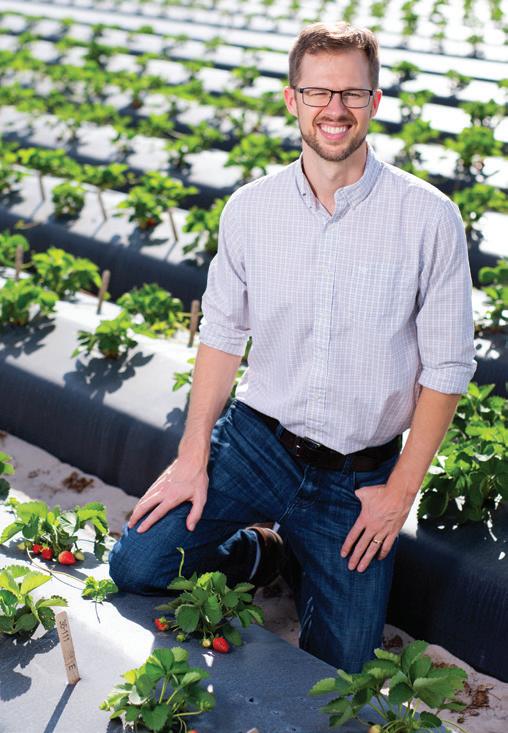
3 minute read
The Fruits of Their Labor
RESEARCHERS AT THE UNIVERSITY OF FLORIDA CREATE TASTIER, HARDIER CROPS
By Nancy Henderson
SCIENTISTS AT THE UNIVERSITY OF FLORIDA’S
Institute of Food and Agricultural Sciences (UF/IFAS) are quietly working year-round to improve the flavor and farmability of some of the state’s top crops.
NATURE’S CANDY
Florida currently ranks as the nation’s second-largest strawberry producer (after California) – but it took a long time to reach that status.
Launched in 1948, the UF/IFAS strawberry breeding program has introduced 15 varieties that are welladapted to local conditions, including its first highly successful variety, ‘Festival,’ in 2000. The strawberrygrowing industry now spans about 11,000 acres in central Florida.
“‘Festival’ kind of changed the landscape of the industry,” says Dr. Vance Whitaker, associate professor of horticulture at the UF/IFAS Gulf Coast Research and Education Center in Wimauma, whose team works to pinpoint the compounds that give strawberries their unique flavor.
The tricky part, Whitaker says, is to create new varieties that satisfy both farmers and consumers. Growers are looking for a not-toodense plant and a long-stemmed berry that can be easily (and more cost-effectively) harvested by hand. They also want plants that fend off diseases caused by humidity, rain and temperature fluctuations in subtropical winters – this is also appealing because fewer diseases merit fewer pesticides.
Customers demand fresh-looking fruits with appealing color and flavor. “In our seedling field now, it’s not too difficult to find a lot of seedlings that have nice, firm strawberries that will ship well from Florida throughout the country,” Whitaker says. “But if that strawberry’s missing a particular disease resistance or flavor, then it goes on the trash pile.”
To get it right, he adds, “You just


have to taste a lot of strawberries, and at all different times in the season. A strawberry might taste good in December, but by the time we get to February, maybe the sugars have gone down and it just doesn’t taste good anymore.”
These days, the state’s strawberry frontrunners are Sweet Sensation® and ‘Florida Brilliance,’ the newest UF cultivar. Growers are currently testing a white-fruited variety with a pink blush and an apricot aroma.
“Florida strawberries are just a healthy product,” Whitaker says. “They’re picked as ripe as possible. They have a lot of vitamin C, fiber and antioxidants.”
TO-MAY-TO, TO-MAH-TO
About 15 years ago, scientists at UF/IFAS set out to understand what made tomatoes so delicious – and what didn’t. Like strawberries, tomatoes derive their flavor from sugars, acids and aromas. “There

Vance Whitaker of the UF/ IFAS Gulf Coast Research and Education Center in Wimauma

are many compounds necessary to give you good tomato flavor,” says Dr. Denise Tieman, UF/IFAS research assistant professor at the UF campus in Gainesville. “It’s not like some fruits, like a banana, where there’s only one compound that you smell.”
Over years of research, Tieman and her colleagues measured the compounds in tomatoes from South America, as well as multiple heirloom, commercial and modern varieties – about 700 altogether. They also enlisted taste testers from the university’s food science and human nutrition department to rate the various types. “We took all that data and did a lot of fancy statistics on it and basically came up with a recipe for the best-tasting tomato overall,” she says. The winners: the sweet, deep red Cherry Roma and Maglia Rosa, which sports a pinkish stripe and a more complex flavor.
The next step was to look at the DNA sequence for all 700 varieties and compare the differences with an eye toward reintroducing the heirloom flavor that had been lost over time in favor of commercial viability (both to extend shelf life and resist disease).
“It was such a gradual thing that people didn’t really notice until we got what we have today, which is not a nice tomato,” Tieman says.
She and her research team are now breeding traits from several heirloom varieties into modern tomatoes to add back the delectable qualities.
“I hope we give you better-tasting tomatoes so that you can have that garden flavor all year-round,” Tieman says. “Tomatoes are big crops for Florida, and they’re one that has a big problem with flavors. So the idea is to make Florida tomatoes, in particular, taste better so that we can sell more of them. That’s good for everybody in the long run.”










